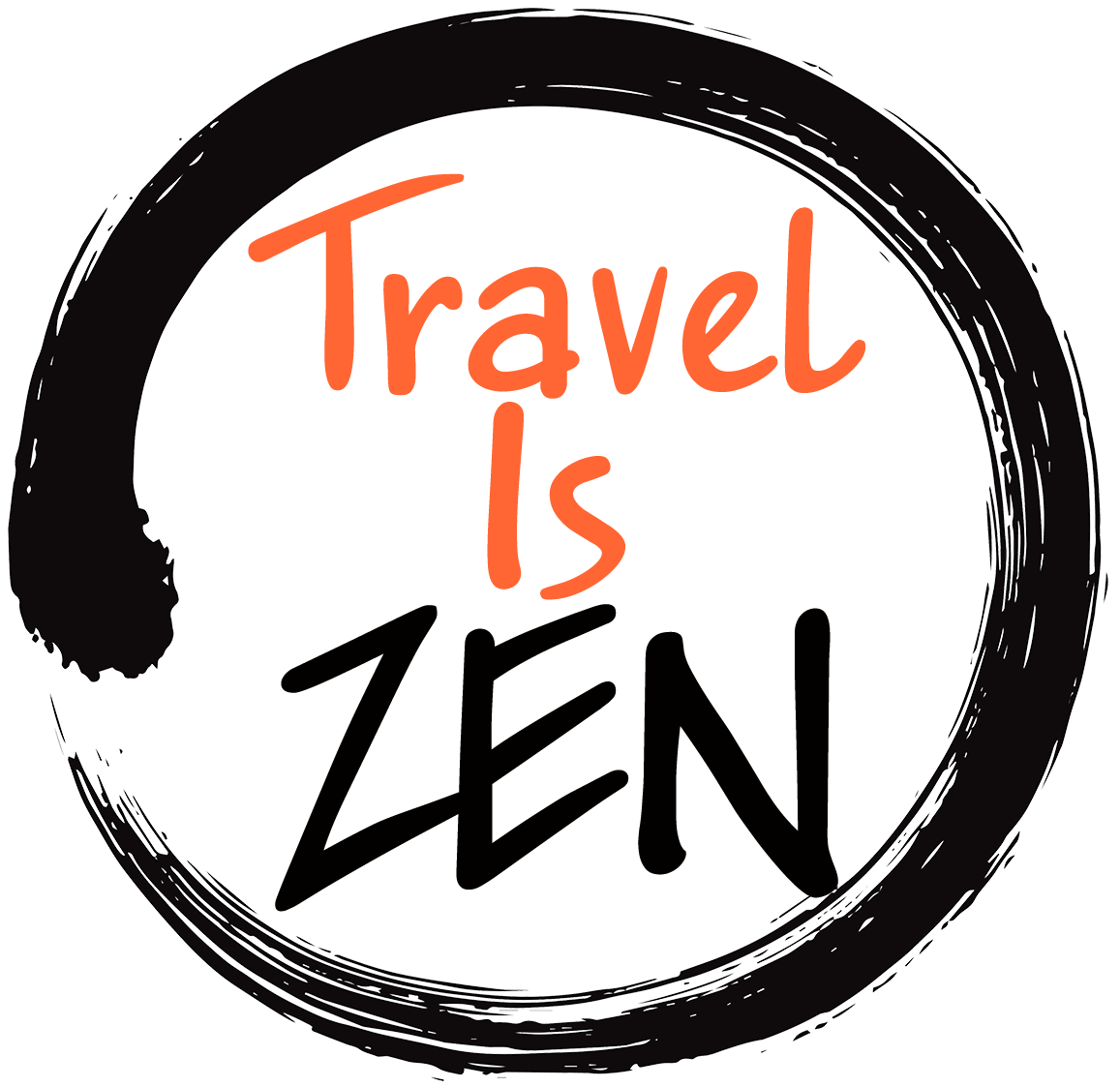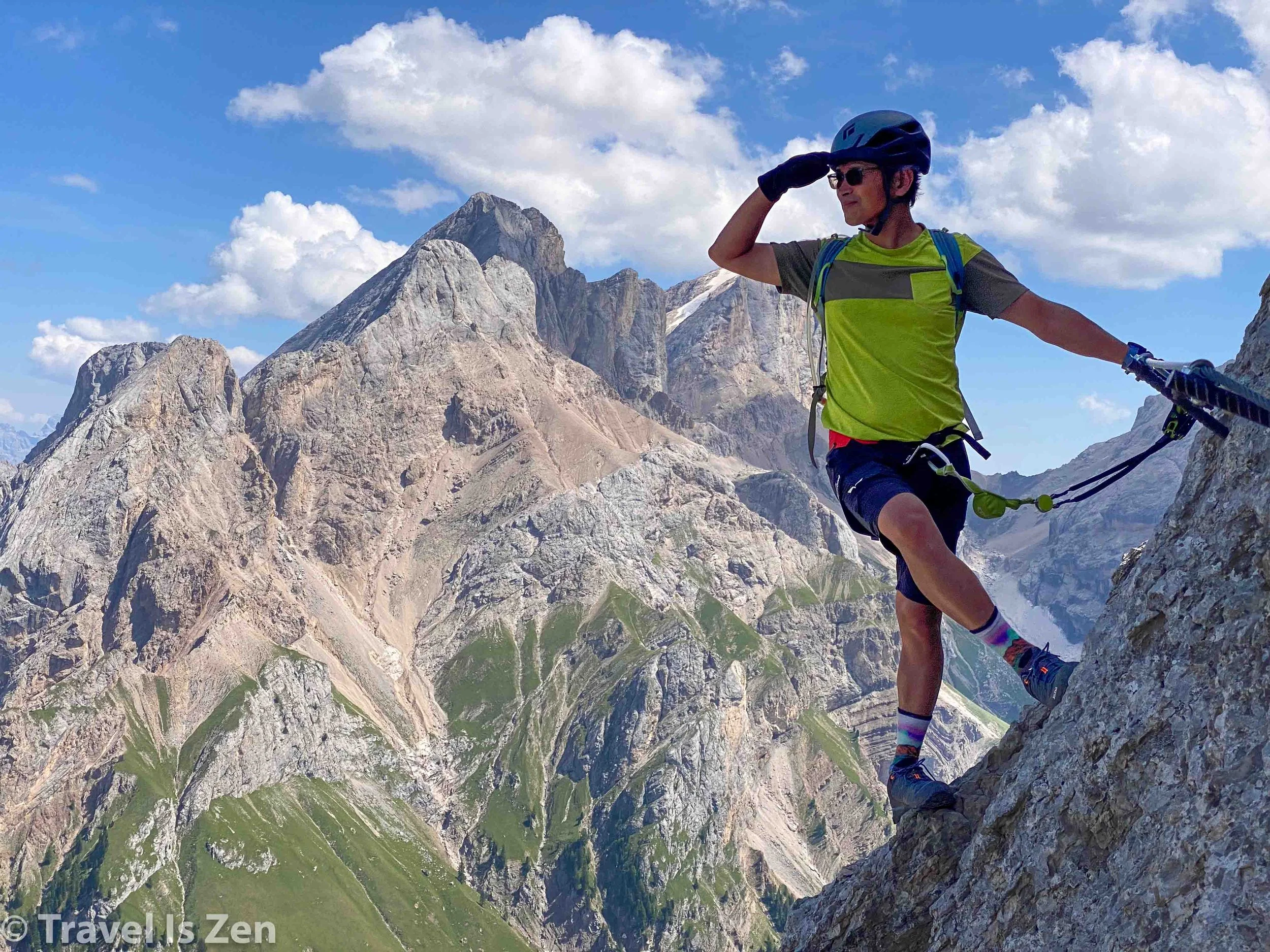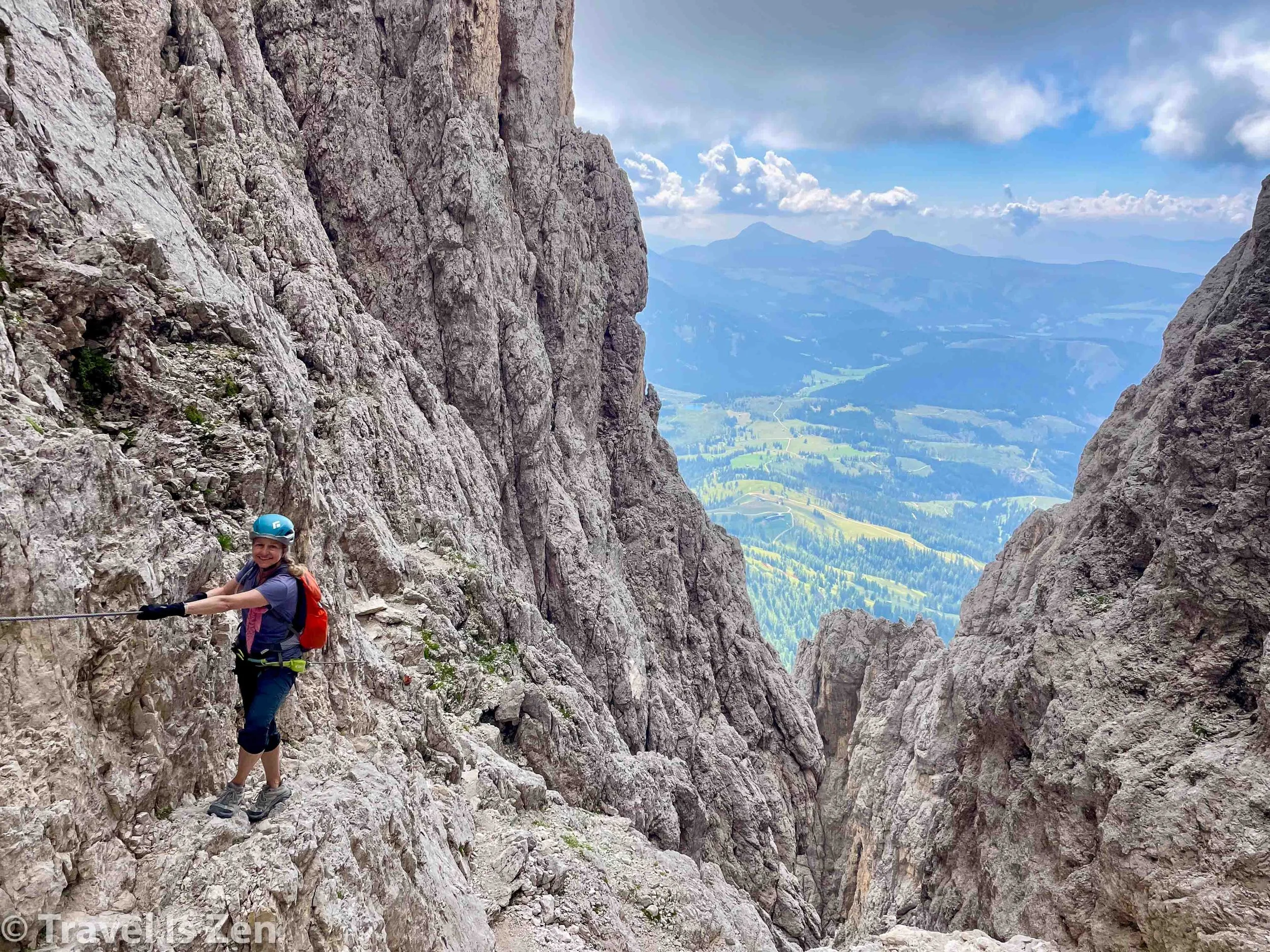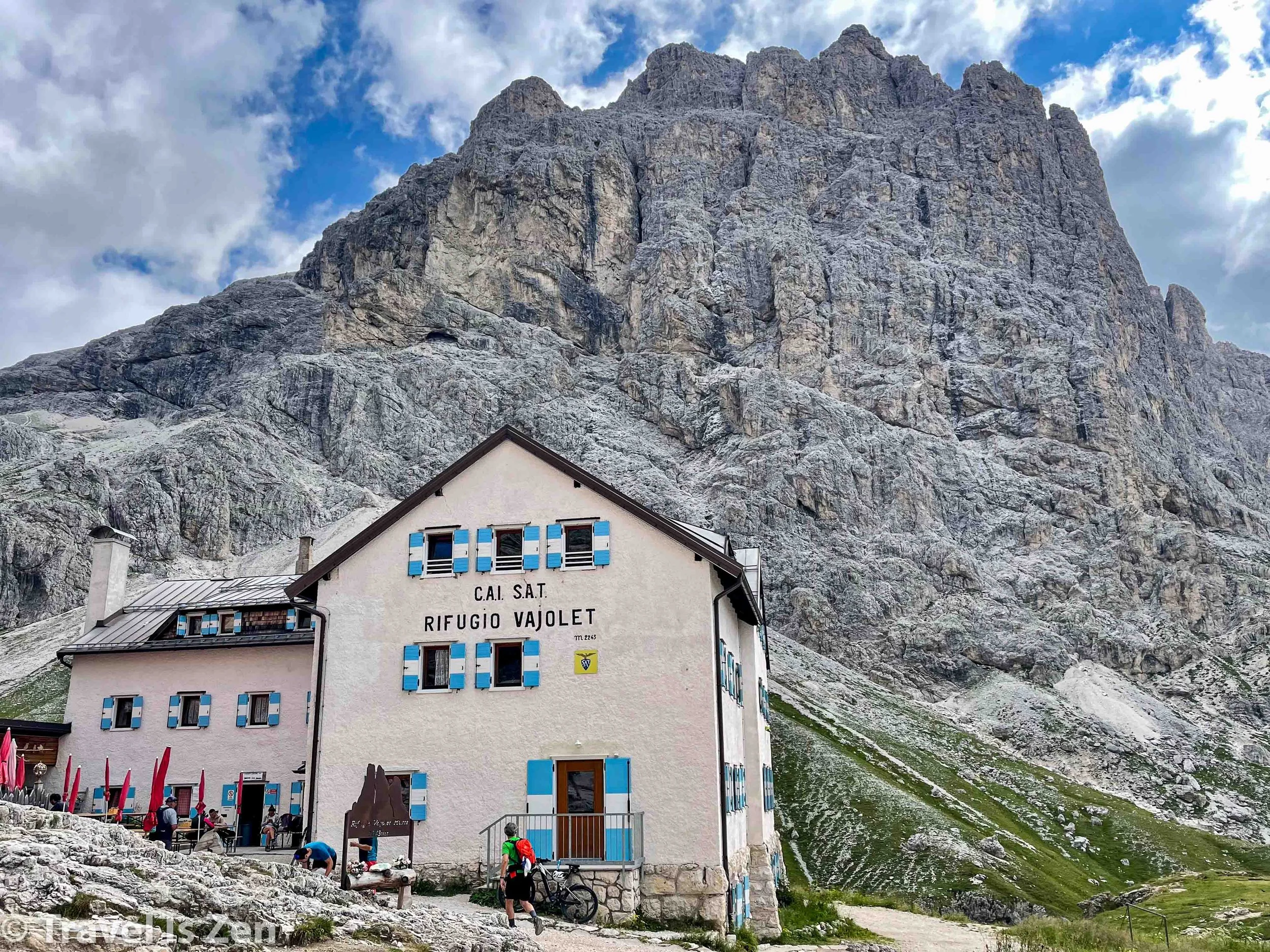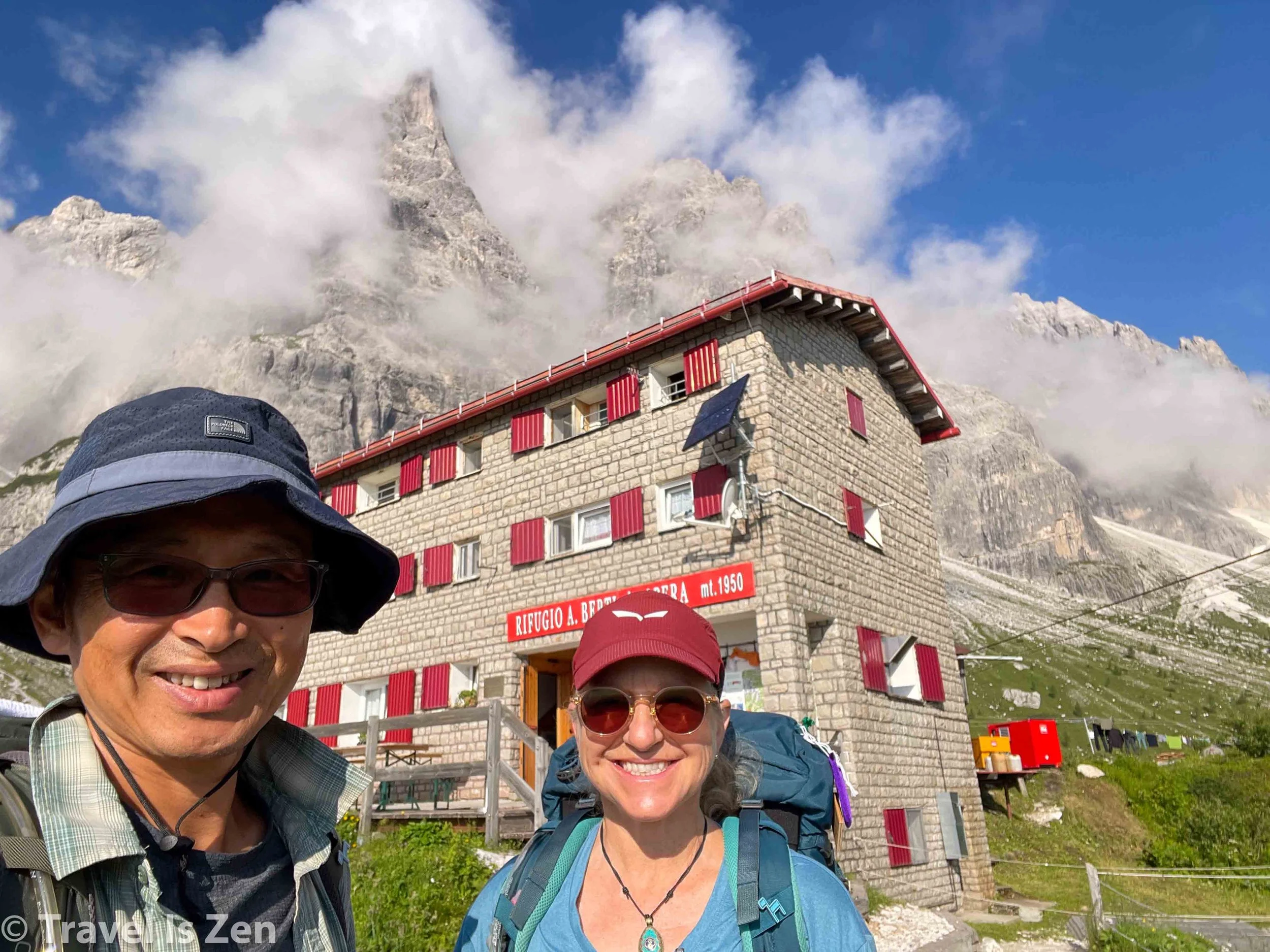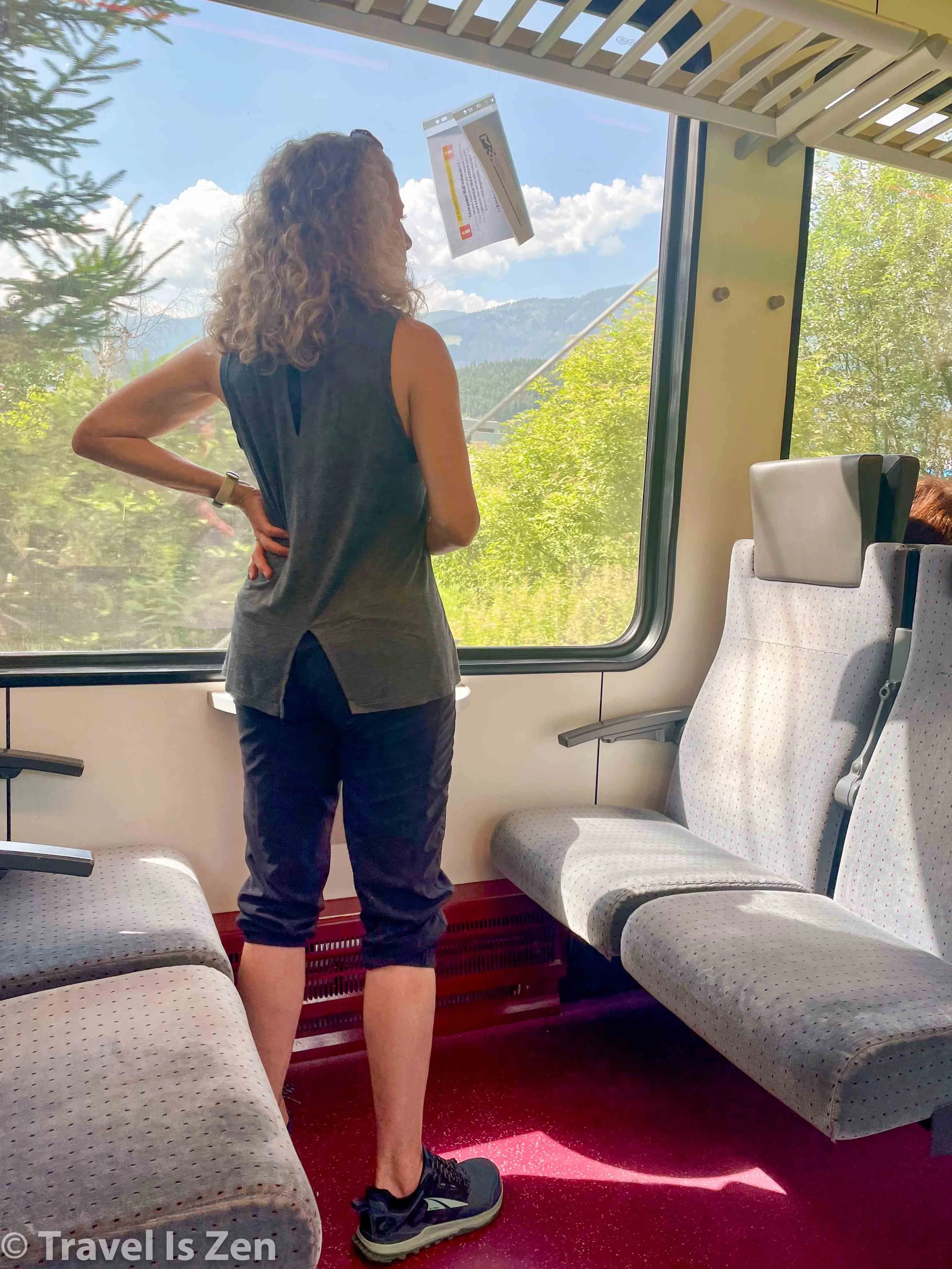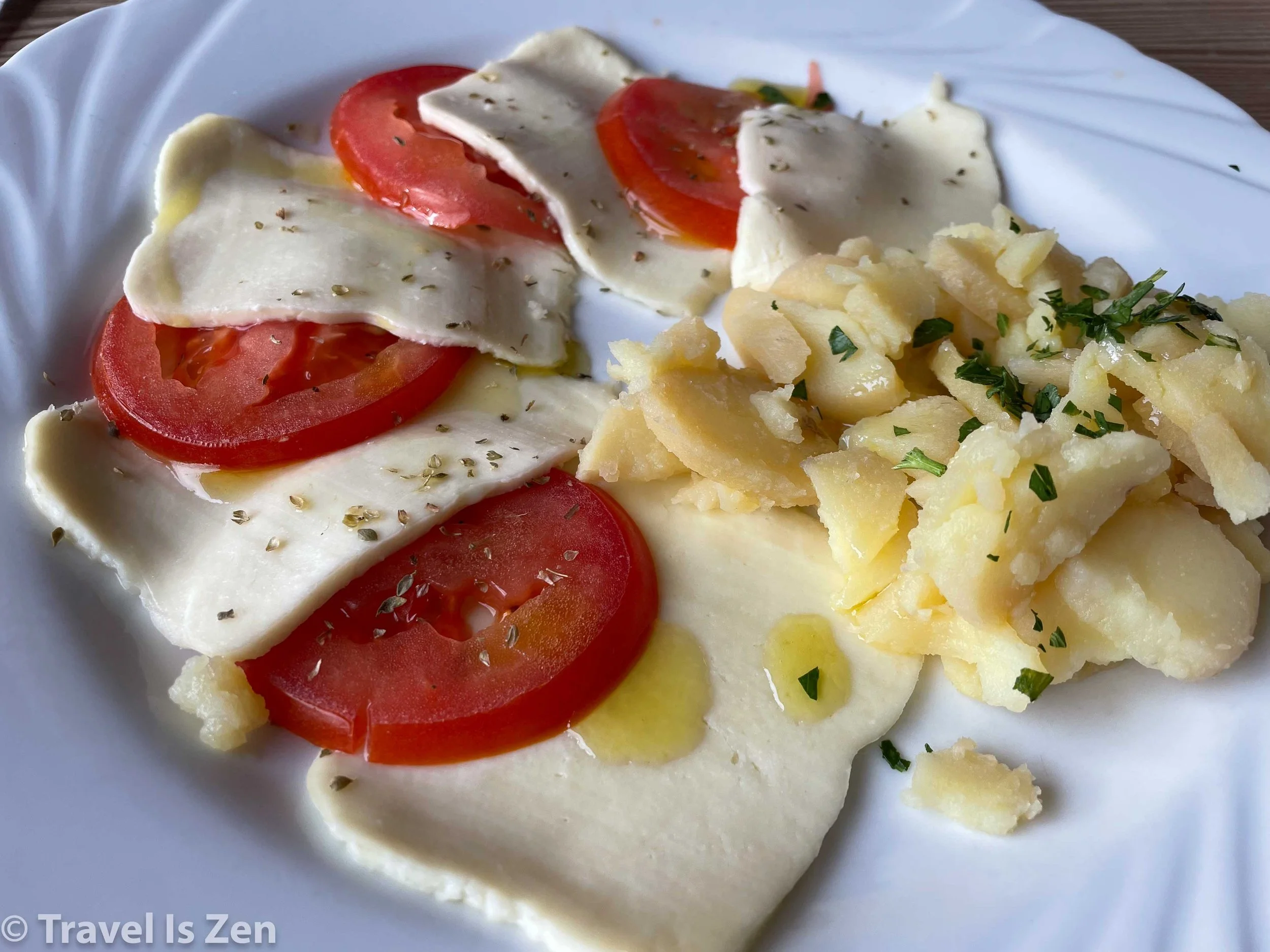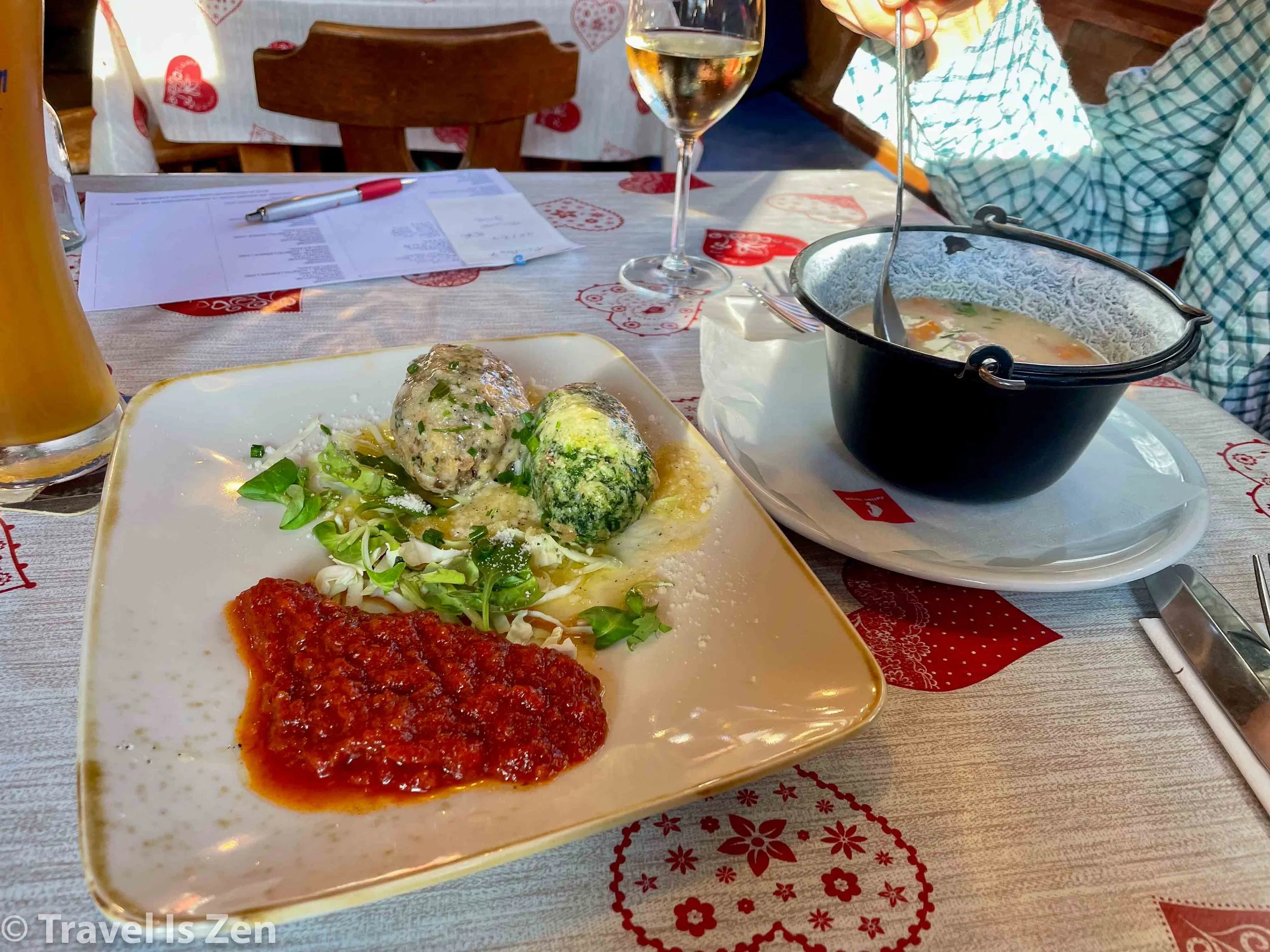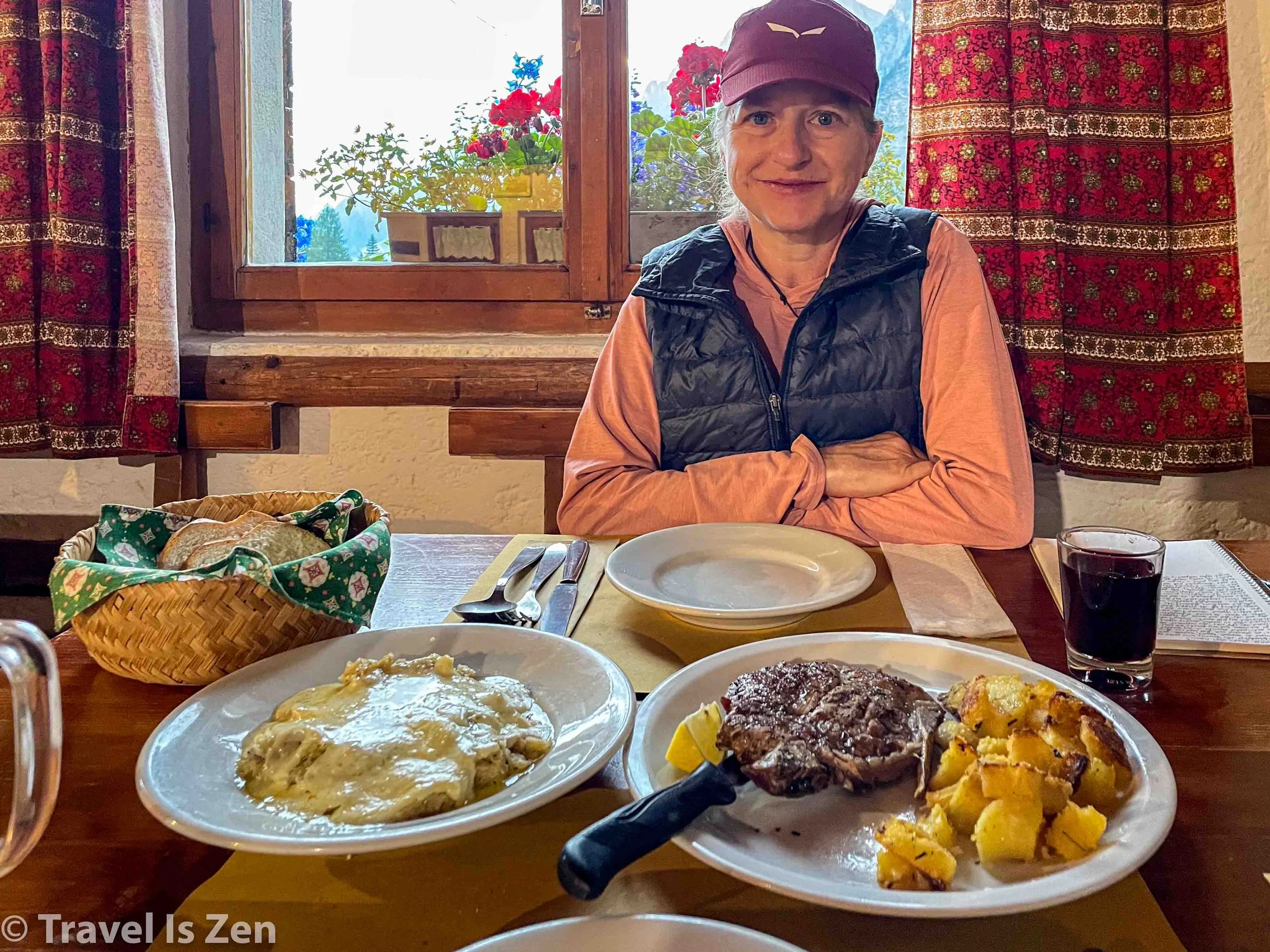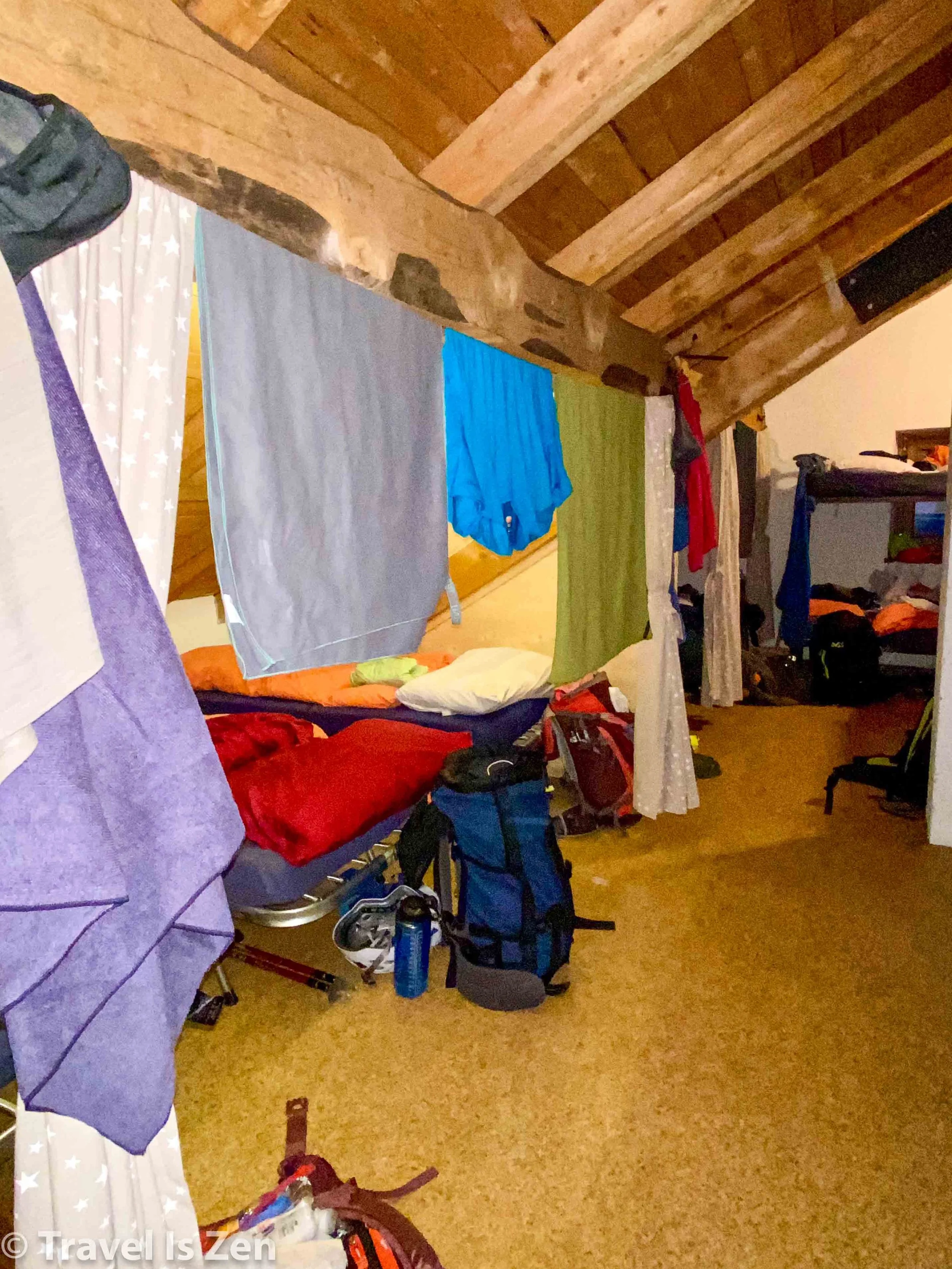Budget and Logistics: Two Months in the Italian Dolomites
We did not plan ahead for our two month summer adventure in the Italian Dolomites. This ran counter to everything we had read prior to our trip. The normal visitor plans a [14] day Italian Alps trip at least 6-12 months in advance. Indeed, to hike a specific multi-day backpacking route (such as the Alta Via 1 or Rosengarten Traverse) with the assurance of onward hut lodging each consecutive night, advance planning is necessary. Since we had loads of time and lots of flexibility, however, we decided to wing it. Planning for 60 days without being in-country was too daunting anyway.
Berti Hut above Val Grande, Belluno Province
General Layout of the Dolomites: National Parks and Valley Towns
The Dolomites extends across an enormous area encompassing multiple national parks, provinces, valleys, major cities, and a myriad of mountain towns. There are a gazillion maps and endless options for what to see and do. We concentrated our time around major valleys in or near four national parks, moving from the east towards the west: Tre Cime, Fanes-Sennes-Brais, Puez Odle, and Rosengarten-Catinaccio. We also ventured south of Cortina d’Ampezzo to Monte Antelao and spent a few days east of Tre Cime in Padola.
Rough sketch of our “route”
Our Main Interests: Via Ferrata and Multi-Night Treks
We first encountered via ferratas in Slovenia and fell in love with high mountain assisted climbing routes. Italy is KING of via ferrata routes, many of them erected during World War I. Our primary interest during our two months in the Dolomites was to maximize time spent on via ferrata routes. Navigate here for the full collection of via ferrata write-ups.
We also wanted to do several multi-night hut-to-hut treks, staying in the mountains for 3 nights or more without returning to town. Most online resources and itineraries would suggest that you must book rifugios months in advance, which is true only for the most well-known and popular huts. Fortunately, there are many private pensions and lesser-known rifugios and we were able to plan several multi-night treks, with reservations made just days in advance.
Valleys, Base Towns, and Rifugios
Fortunately, most of the via ferratas in the Dolomites are accessible via public transportation and a short hike from key “base” towns throughout the Dolomites. Our approach was to book 3-5 nights in a valley town inn or hotel and take a bus and/or cable car to day-hike nearby via ferrata courses. When we finished the courses in each area that we were interested in, we would move to the next base valley town and repeat. This approach also allowed time to explore key bucket-list attractions in each area, such as Tre Cime di Lavaredo, Lago di Braes, Alpe di Suisi, Seceda, etc. Throughout our time in the Dolomites, we based ourselves in or near Val Pusteria (Dobbiaco), Val Gardena (Orteisei), Val di Fassa (Vigo di Fassa), and Val Cadore (San Vito di Cadore). Navigate here for the full collection of write-ups covering base valleys and towns.
As mentioned above, we wanted to do several multi-night treks. We knew our challenge for a hut-to-hut trek would be stringing together a series of rifugios along well-known routes. The most easily-accessible huts were already booked solid. There is no single online discovery and booking system for the hundreds of rifugios scattered throughout the Dolomites. We learned that every valley in the Dolomites “competes” for tourist dollars and, therefore, puts together extensive information on the sites, inns, rifugios, dining options, and public transportation within their respective domains. When based in a valley town, we would visit the local tourism center and obtain local maps, lodging directories, etc. With this information, we could discover and reserve beds at the lesser-known or more remote rifugios (there were plenty) - sometimes we could book online; other places only took phone reservations. We also learned that most rifugios are located near multiple trails and via ferratas, so we could stay a few nights at a single hut and cover a lot of ground (rather than try to continuously move forward from point A to point B). This worked splendidly for us!
None of this is obvious when you attempt to plan a multi-day mountain trek using guidance from online resources and blogs. They all follow the same advice and well-loved itineraries, so there is a ton of missing information. Just know that, if you are late to the planning game, you still have options. Contrary to popular belief, you do not necessarily need to book everything months in advance.
** NOTE: If you prefer sleeping in a tent, campgrounds are an alternative to rifugios… although we found campgrounds to be just as expensive and elusive as booking a rifugio bed! Tent camping outside of designated campgrounds is illegal everywhere in the Dolomites.
Public Transportation Works!
Another piece of advice you will get online is that it’s essential or ideal to rent a car. Not true. In fact, the train, bus and cable car system throughout the Dolomites is superb. We never had a car and never needed one. Valleys and major towns are connected by train or cross-provincial bus lines; every valley also has local bus service to cable car stations and points of popular interest. Some valleys offer a “guest pass” provided by hotels and inns that enables guests to ride local buses for FREE. There are also money-saving multi-day cable car lift passes offered in some valleys. Finally, taxis are also an option (although a bit expensive).
Despite the phenomenal public transportation, traffic through the valley towns is a constant kluge; endless lines of bumper-to-bumper cars, campers, and motorcycles. Don’t add to the insanity! If anyways you are going to sit in traffic, do it in an air-conditioned luxury public transport bus. I repeat: You do NOT need a car.
$$ Budget $$
A trip to the Dolomites during the height of summer tourism is not cheap. July and August are the only two months of the year when the mountain trails and via ferratas are nearly free of snow and all of the rifugios are open. If you intend to hike peaks, rock climb, or via ferrata, this is not a place you can visit with confidence in the shoulder season. Even in early July, one of the via ferratas we wanted to do was closed, still covered in snow AND just a week after we left the Dolomites, a huge snowstorm hit the mountains in early September.
Given the weather reality, there is high demand and thus high prices in July and August. A simple bed in a rifugio dormitory room with half board averaged $75+ per person, per night. As a couple, each night we spent in a mountain hut typically cost us ~$150+. We purchased an alpine club membership (€45/each) that was supposed to save us money on lodging, but we learned that many of the rifugios are privately operated or belong to different alpine clubs or just don’t accept club cards. The CAI alpine membership provides emergency search, rescue, and insurance; we were glad we had it, but it didn’t save us money at the huts (unlike our experience in Slovenia, where the alpine membership saved us a ton). In the valley towns, we spent between USD $250-300+ per night at local pensions and hotels — and these were the budget options.
Food
Rifugio food is excellent and abundant. Half-board option at rifugios include dinner and breakfast. Dinner is usually two generous courses (such as hearty soup or pasta + potatoes and pork chops), along with bread and dessert. Breakfast is normally a selection of breads, spreads, meats and cheese, along with yogurt and juices. Of course, valley towns are filled with an amazing array of restaurant choices, ranging from low- to high-end prices. You will never suffer a lack of food options in Italy!
Money Saving Tips
So, is it possible to save money while traipsing about the Dolomites? Perhaps sleeping in a tent or packing in food? On one rare occasion, we saw people pitching a tent outside of a rifugio - they had permission to do so by the hut owner AND the area around the hut was conducive to pitching a tent. This was not the norm. If you prefer sleeping in a tent, campgrounds exist in the valleys, but they are just as expensive and hard to reserve as booking a rifugio bed, so campgrounds won’t save you much time or money. To preserve the pristine Dolomites environment, it is not legal to wild camp anywhere in the Dolomites. There are steep fines if you are caught tent camping outside a designated campground. We did encounter a few people doing it, but it seemed quite challenging to find a comfortable, hidden spot.
While bringing your own meals into the mountains might seem like a way to save money, in reality, it won’t save you much euro, will weigh down your pack load, AND you would miss out on excellent regional cuisine! Instead, here are a few ways to save money in the Dolomites mountain huts:
In the mountains, stay in a dorm-style room, rather than a private room (bring your headphones and Tylenol PM).
Avoid alcoholic beverage purchases at the hut.
Use your own water filter, rather than buying bottled water at rifugios.
Bring your own snack foods for sustenance between half-board meals, if needed.
Choose a “hiker bath” (handkerchief wipe-down) over a paid shower at the rifugio.
Make a sandwich at breakfast from the buffet options and grab a piece of fruit to stash in your pack for lunch. I was unsure about the etiquette of this, but Italians assured us it was somewhat of a general practice. If a rifugio owner frowns on “breakfast pilfering”, you will know it. For example, they will be stingy with bread (e.g. bring bread to your table that is just enough for breakfast and charge extra for another basket, rather than putting bread on the buffet).
Purchase a single-ride cable car pass either UP or DOWN the mountain and then trail hike the opposite direction; there is always a trail option that follows the general route of a cable car. We often rode up to higher elevation, hiked or did a via ferrata, and then walked back to town along a trail. This saves up to $50 a ride for two people, which adds up to quite a lot over several days or weeks.
While staying in valley towns, reserve apartments with a kitchen so you can grocery shop and cook some of your own meals. Avoid resorts! Stay in local pensions, which are cheaper, more intimate and staffed by knowledgeable local people. Inquire about public transportation perks in every valley town — many tourism boards offer free bus passes or discounted cable car tickets. Always worth taking the time to understand how to get around each region.
Our High-Level Itinerary (Below Map)
Map showing territory covered during two months in the Dolomites
JULY 5-7 Journey to the Dolomites: flew into Italy from South Korea, flying through Munich to Verona and then train to Bolzano
JULY 7-25 East and Mid-East Dolomites Region: Tre Cime Nature Park and Fanes-Sennes-Brais Nature Parks, Base Town: Dobbiaco in Val Pusteria + a few days in Padola (Belluno, Veneto)
JULY 25-AUG 3 Mid-West Dolomites Region: Puez Odle Nature Park, Base Town: Ortisei in Val Gardena
AUG 3-AUG 11 West Dolomites Region: Rosengarten-Catinaccio Nature Park, Base Town: Vigo di Fassa in Val di Fassa
AUG 11-15 Central Dolomites Region: Marmolada and the Sella Group, Base Town: Canazei
AUG 16-21 South-East Dolomites Region: Monte Lagazuoi and the Sorapsis Group, Base Town: San Vito di Cadore (south of Cortina d’Ampezzo)
AUG 21-28 West Dolomites Region (round 2): Rosengarten-Catinaccio Nature Park, Base Town: Vigo di Fassa in Val di Fassa
AUG 28: Left the Dolomites by train from Bolzano to Milan; spent a final week resting in a small suburb town
Read on for more information about our Two Months in the Dolomites, including detailed information about base towns, valleys, via ferrata details, day hikes, and site-seeing…
